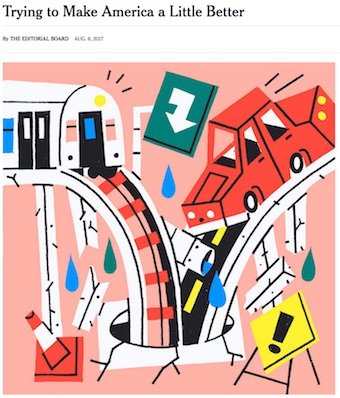Infrastructure repair “should be a bipartisan no-brainer,” according to an editorial in today’s New York Times, but there may be a rough road ahead for the selling of a potential $1T program to US taxpayers.
Brodeur Worldwide points out the challenges connected with “Get America Rolling Again.”
The Boston-based firm recently released a report called “Making Infrastructure Relevant Again” that found a chasm between the views of experts (e.g., American Society of Civil Engineers grades America’s infrastructure a D+) and voter perception of the problem.
 |
Despite all the campaign rhetoric surrounding the dire need to repair the nation’s infrastructure and the depiction of US airports as Third-World facilities, large majorities of respondents to Brodeur’s survey gave passing grades to seven infrastructure components—roads/bridges; dams; mass transit; Amtrak; water systems; electrical grid, and airports/air traffic control system.
Trump voters were more likely than Clinton supporters to rate infrastructure as either “excellent” or “good.”
According to Brodeur’s survey, the NYT got it completely wrong in pitching infrastructure as “one of the practical job-building promises of the Trump presidential campaign.”
The public puts little stock in the dream of thousands of well-paying blue-collar construction jobs working on the infrastructure.
Survey respondents rate health, safety and security as the top benefit of infrastructure repair.
From the Report:
“We’ve seen bridges collapse, water systems contaminated and dams fail. But the health and safety benefits of infrastructure investment don’t appear to be as prominent in messaging then things like productivity, jobs and financing.
“The opportunity for advocates of infrastructure is to go beyond the economic benefits and show how investments now can improve health, prevent accidents and save the lives of family, friends and their communities in the future.”
And then there’s the $64K question: Where do we get the money for a nationwide infrastructure program?
Forty-two percent of respondents say funding should come from budget cuts elsewhere, while 27 percent support a tax increase to pay for infrastructure repair and 31 percent support a blending of the two.
The survey shows that infrastructure repair may not be the slam-dunk issue to bridge the partisan divide among Republicans and Democrats.
It will take messaging built around public health and safety combined with a funding package comprised of tax increases and budget cuts to get those shovels into the ground.


 The ridiculously high prices Americans are paying at the supermarket might influence how—or if—they vote in November.
The ridiculously high prices Americans are paying at the supermarket might influence how—or if—they vote in November. At a moment in history when there are so many conflicts among peoples here and abroad, let us put our differences aside and celebrate this wonderful season in a spirit of togetherness.
At a moment in history when there are so many conflicts among peoples here and abroad, let us put our differences aside and celebrate this wonderful season in a spirit of togetherness. The news announcing the death of Henry Kissinger, the last of the prevaricating politicians and so-called statesmen who stole my future and that of thousands of other young Americans, got me thinking about Walter Cronkite.
The news announcing the death of Henry Kissinger, the last of the prevaricating politicians and so-called statesmen who stole my future and that of thousands of other young Americans, got me thinking about Walter Cronkite.


 Have a comment? Send it to
Have a comment? Send it to 
No comments have been submitted for this story yet.